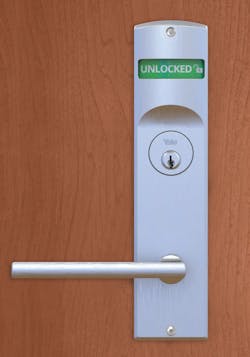In door hardware, the term “function” defines how the locking device operates.
Familiarity with lock functions is critical if you’re involved with door controls, life safety and electronic access control (EAC) systems, because mechanical and electromechanical locks are still and probably will continue to be, essential ingredients in physical security.
In security, we also use the term “function” to describe how devices that are combined to work together operate. If your work includes mechanical locks, accurately describing how the lock is supposed to function is a good starting point.
Because physical security is a dynamic technology, new functions are added frequently. There are more than 60 ANSI lock functions today among cylindrical and mortise locks and exit devices.
The Standards
In the case of cylindrical locks, mortise locks and exit devices, the relevant standards are:
- ANSI/BHMA A156.2-2017 (for bored and preassembled locks and latches)
- ANSI/BHMA A156.13-2017 (for mortise locks and latches)
- ANSI/BHMA A156.3-2020 (for exit devices)
If you’re involved with specifying locks, you might wish to purchase the standards that are relevant to your areas of locksmithing. You also might obtain information on lock functions from the lock manufacturers, and lock distributors are excellent sources of technical support.
After you’ve documented how the lock will be required to operate, you can find an ANSI function that most closely matches your requirements.
My own activities in security frequently involve integrating mechanical locks with electronic devices to arrive at more-complex solutions, and I used the expression “theory of operation” to define my process.
While the project was still in a conceptual phase, using the word “theory” sounded tentative and wishful, but after the design was complete and debugged, it wasn’t a theory any longer, but a fact. The theory of operation detailed how the system would operate when it was installed professionally, used properly and operated correctly.
For example, when it’s desired to unlock a door electrically, a mechanical lockset might be combined with an electric strike. Thus, you could come up with a “theory of operation” you could review to determine that the solution complies with building and life-safety codes while fulfilling the client’s expectations.
Cylindrical locks have a latch, two knobs, one or two lock cylinders (key in knobs) or a turn piece on the inner knob, so lock functions typically are simple and limited. But we also use mortise locks and exit devices, which have other features, such as deadbolts, and other means of controlling them, such as trim. We also might integrate the lock with keypads, timers and status indicators. The large number of available ANSI lock functions reflects the extensive number of combinations that are possible.
Note that although there are many ANSI functions and they’re published as three distinct categories, the majority of locks we use have fewer than 10 possible functions. In other words, many of the ANSI functions are for specific applications.
But lock manufacturers also apply their own numbering systems to organize their locks’ functions, so having a familiarity with the basic functions and the terminology will help security pros to deal with the challenges likely to be encountered when working with locking device specifications. That’s because, occasionally, a manufacturer’s function code won’t match up with an ANSI function code, and you’ll have to sort out the differences. (It always amazed me how many individuals involved in EAC and system integration have little interest in acquiring knowledge about locks and lock functions.)
When in doubt, consult the manufacturer’s catalog.
Lock Functions
As security management demands become increasingly complex, so, too, can be the solutions.
Many different lock functions are available, but the majority of locks specified include one of six primary mechanical functions. Nevertheless, having exposure to and an understanding of all functions will enable you to best advise and service your clients. Here are the six primary functions.
Passage Sets. In a passage set, there’s no key cylinder and no means to lock it. These are used where doors have to remain latched but don’t have to lock.
Privacy Sets. Privacy sets often are used for single-occupant restrooms or dressing rooms. They can be locked from the inside via a thumbturn or a push-button or turn, and they typically are unlocked from the outside by using a tool rather than a key. One variant of this function is the hospital privacy set, which has a thumbturn on the inside and outside to allow hospital staff to have quick access to a bathroom. Such functions also might incorporate an indicator to show the locked status of the door.
Storeroom Locks. For storeroom locks, the outside lever remains locked at all times. A key retracts the latchbolt and allows you to open the door. When the key is released, the door is relocked.
Office Locks. Office locks may be controlled by a key in the outside cylinder or by a thumbturn or push-button or turn on the inside. The outside lever may be left in a locked or unlocked position. The use of the thumbturn or button provides convenience to the user but also might allow an unauthorized person to control the lock, so this lock should be used where unauthorized use isn’t a concern.
Classroom Locks. Classroom locks are controlled by a key in the outside cylinder, which locks or unlocks the outside lever. The lock can be left locked or unlocked by using a key.
Classroom Security Locks. Classroom security locks are a relatively new function. They allow control of the outside lever via a key cylinder on the inside and outside of a door. Locks that have this function are great for where it isn’t desirable to leave a room to lock the door.
When it comes to electrified locksets, two functions that you probably are well-aware of are the most commonly used: electrically locked (fail-safe) or electrically unlocked (fail-secure). When electricity is applied to a mortise lock, for example, the outside lever is locked, but the inside lever always allows free egress (fail-secure). When electricity is removed from the lock, the outside lever is unlocked, which makes it fail-safe. The locking of the outside lever also can be controlled by a key that retracts the latch momentarily.
For more functions and information, go to ansi.org.
Tim O’Leary is an experienced security consultant and a regular contributor to Locksmith Ledger.
A Few Words About UL
Most locks have a function code, but only some are UL listed. It’s worth noting UL’s role in door hardware. The hardware industry, and many others, use UL as their benchmark. UL is a testing laboratory that tests to determine whether hardware complies with a “standard.”
Keep in mind, UL doesn’t approve anything. There’s no such thing as UL-approved hardware. (The local authority having jurisdiction approves things.) However, UL does a few things:
UL lists. UL listed means that a product passed testing. The UL label shows the category that UL employed for testing. A panic bar might be labeled a “listed exit device.” A maglock might be labeled “listed auxiliary lock.”
The label also will include a four-letter code, for example GWXT, which is assigned based on the product category and type of tests. (By the way, GWXT is for maglocks.)
UL recognizes. UL recognized is the status UL grants to a component that has to be combined with other components to create a finished product. A recognized component is one where the complete safety in its application can’t be evaluated by looking at the component alone, so conditions of acceptability are placed around its use. It has to be used in that specific context for it to satisfy safety requirements.
UL classifies. UL classification is a service whereby UL determines that a manufacturer has demonstrated the ability to produce a product that complies with UL requirements for the purpose of classification or evaluation with respect to one or more of the following:
- Specific risks only, such as casualty, fire or shock
- Performance under specified conditions
- Regulatory codes
- Other standards, including international
- Other conditions that UL might consider to be desirable.
UL authorizes manufacturers to use UL’s Classification Mark on products that comply with UL requirements and establishes followup service as a check of the means the manufacturer exercises to maintain compliance with UL requirements.
UL certifies. UL certified means a product has been tested successfully by UL to a non-UL standard. Most often that’s an ANSI standard.
List of Manufacturers
Following is a partial list of manufacturers and brands that make cylindrical or mortice locks or exit devices.
Adams Rite: www.adamsrite.com
Alarm Lock: www.alarmlock.com
Arrow: www.arrowlock.com
Baldwin: www.baldwinhardware.com
BEST: www.bestaccess.com
Cal-Royal: www.cal-royal.com
Codelocks: www.codelocks.us
Command Access: www.commandaccess.com
Corbin Russwin: www.corbinrusswin.com
Detex: www.detex.com
dormakaba: www.dormakaba.com
Dynalock: dynalock.com
Emtek: emtek.com
Falcon: us.allegion.com
Hager: www.hagerco.com
Marks: marksusa.com
Omnia Industries: www.omnia.com
Paxton: www.paxton-access.com/us/
PDQ: www.pdqlocks.com
Precision Hardware: www.precisionhardware.com
Progressive Hardware: www.progressivehardware.net
SARGENT: www.sargentlock.com
Schlage: us.allegion.com
SDC: sdcsecurity.com
SECO-LARM: www.secolarm.com
Securitech: www.securitech.com
TownSteel: www.townsteel.com
Von Duprin: us.allegion.com
Yale: www.yalecommercial.com
About the Author
Tim O'Leary
Tim O'Leary is a security consultant, trainer and technician who has also been writing articles on all areas of locksmithing & physical security for many years.

